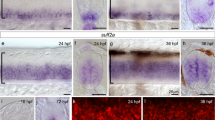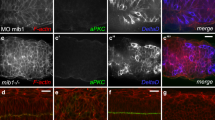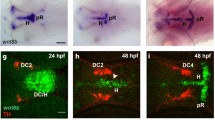Abstract
Specification of distinct neuron types in the ventral spinal cord is thought to be mediated by a graded concentration of Sonic hedgehog (Shh), a secreted signaling protein. Shh is made in the notochord, the most ventral part of the spinal cord, and in mice lacking Shh, ventral cell types are reduced or absent. The response to Shh depends on transcription factors of the Gli family, but the detailed mechanism is not understood. Here we show that Gli3 represses ventral fates in a dose-dependent manner. Whereas Shh−/− mutant mice show reductions in several classes of ventral interneurons and a complete absence of motor neurons, these cell types were rescued in Shh−/−;Gli3−/− double mutants. This rescue of the Shh null phenotype depended on the level of Gli3 function; a partial rescue was observed in Shh−/−;Gli3+/− embryos. We propose that Shh is required to antagonize Gli3, which would otherwise repress ventral fates. Differences between rostral and caudal regions suggest that other signaling molecules—in addition to Shh—may be involved in specifying ventral fates, particularly in the caudal region of the spinal cord.
This is a preview of subscription content, access via your institution
Access options
Subscribe to this journal
Receive 12 print issues and online access
$209.00 per year
only $17.42 per issue
Buy this article
- Purchase on Springer Link
- Instant access to full article PDF
Prices may be subject to local taxes which are calculated during checkout






Similar content being viewed by others
References
Lee, K. J. & Jessell, T. M. The specification of dorsal cell fates in the vertebrate central nervous system. Annu. Rev. Neurosci. 22, 261–294 ( 1999).
Ericson, J. et al. Pax6 controls progenitor cell identity and neuronal fate in response to graded Shh signaling. Cell 90, 169–180 (1997).
Ericson, J., Briscoe, J., Rashbass, P., van Heyningen, V. & Jessell, T. M. Graded sonic hedgehog signaling and the specification of cell fate in the ventral neural tube. Cold Spring Harbor Symp. Quant. Biol. 62, 451– 466 (1997).
Roelink, H. et al. Floor plate and motor neuron induction by different concentrations of the amino-terminal cleavage product of sonic hedgehog autoproteolysis. Cell 81, 445–455 ( 1995).
Briscoe, J. et al. Homeobox gene Nkx2.2 and specification of neuronal identity by graded Sonic hedgehog signalling. Nature 398, 622–627 (1999).
Tabin, C. J. & McMahon, A. P. Recent advances in Hedgehog signalling . Trends Cell Biol. 7, 442– 446 (1997).
Goodrich, L. V. & Scott, M. P. Hedgehog and patched in neural development and disease. Neuron 21 , 1243–1257 (1998).
Ingham, P. W. Transducing hedgehog: the story so far. EMBO J. 17, 3503–3511 (1998).
Aza Blanc, P. & Kornberg, T. B. Ci: a complex transducer of the hedgehog signal. Trends Genet. 15, 458 –462 (1999).
Ruppert, J. M., Vogelstein, B., Arheden, K. & Kinzler, K. W. GLI3 encodes a 190-kilodalton protein with multiple regions of GLI similarity . Mol. Cell Biol. 10, 5408– 5415 (1990).
Kinzler, K. W., Ruppert, J. M., Bigner, S. H. & Vogelstein, B. The GLI gene is a member of the Kruppel family of zinc finger proteins. Nature 332, 371–374 ( 1988).
Dai, P. et al. Sonic Hedgehog-induced activation of the Gli1 promoter is mediated by GLI3. J. Biol. Chem. 274, 8143– 8152 (1999).
Ruiz-i-Altaba, A. Gli proteins encode context-dependent positive and negative functions: implications for development and disease. Development 126, 3205–3216 (1999).
Shin, S. H., Kogerman, P., Lindstrom, E., Toftgard, R. & Biesecker, L. G. GLI3 mutations in human disorders mimic Drosophila cubitus interruptus protein functions and localization . Proc. Natl. Acad. Sci. USA 96, 2880– 2884 (1999).
Wang, B., Fallon, J. F. & Beachy, P. A. Hedgehog-regulated processing of Gli3 produces an anterior/posterior repressor gradient in the developing vertebrate limb. Cell 100, 423–434 ( 2000).
Sasaki, H., Nishizaki, Y., Hui, C., Nakafuku, M. & Kondoh, H. Regulation of Gli2 and Gli3 activities by an amino-terminal repression domain: implication of Gli2 and Gli3 as primary mediators of Shh signaling. Development 126, 3915– 3924 (1999).
Ruiz-i-Altaba, A. Gli proteins encode context-dependent positive and negative functions: implications for development and disease. Development 126, 3205–3216 (1999).
Ruiz i Altaba, A. Combinatorial Gli gene function in floor plate and neuronal inductions by Sonic hedgehog. Development 125, 2203– 2212 (1998).
Hui, C. C., Slusarski, D., Platt, K. A., Holmgren, R. & Joyner, A. L. Expression of three mouse homologs of the Drosophila segment polarity gene cubitus interruptus, Gli, Gli-2, and Gli-3, in ectoderm- and mesoderm-derived tissues suggests multiple roles during postimplantation development. Dev. Bio. 162, 402–413 (1994).
Sasaki, H., Hui, C., Nakafuku, M. & Kondoh, H. A binding site for Gli proteins is essential for HNF-3β floor plate enhancer activity in transgenics and can respond to Shh in vitro. Development 124, 1313–1322 ( 1997).
Hynes, M. et al. Control of cell pattern in the neural tube by the zinc finger transcription factor and oncogene Gli-1. Neuron 19, 15–26 (1997).
Ding, Q. et al. Diminished Sonic hedgehog signaling and lack of floor plate differentiation in Gli2 mutant mice. Development 125, 2533 –2543 (1998).
Matise, M. P., Epstein, D. J., Park, H. L., Platt, K. A. & Joyner, A. L. Gli2 is required for induction of floor plate and adjacent cells, but not most ventral neurons in the mouse central nervous system. Development 125, 2759–2770 (1998).
Park, H. L. et al. Mouse Gli1 mutants are viable but have defects in SHH signaling in combination with a Gli2 mutation. Development 127 , 1593–1605 (2000).
Chiang, C. et al. Cyclopia and defective axial patterning in mice lacking Sonic hedgehog gene function. Nature 383, 407– 413 (1996).
Hui, C. C. & Joyner, A. L. A mouse model of greig cephalopolysyndactyly syndrome: the extra-toes mutation contains an intragenic deletion of the Gli3 gene. Nat. Genet. 3, 241– 246 (1993).
Buscher, D., Grotewold, L. & Ruther, U. The XtJ allele generates a Gli3 fusion transcript. Mamm. Genome 9, 676–678 (1998).
Theil, T., Alvarez-Bolado, G., Walter, A. & Ruther, U. Gli3 is required for Emx gene expression during dorsal telencephalon development . Development 126, 3561– 3571 (1999).
Goulding, M. D., Lumsden, A. & Gruss, P. Signals from the notochord and floor plate regulate the region-specific expression of two Pax genes in the developing spinal cord . Development 117, 1001– 1016 (1993).
Ericson, J., Morton, S., Kawakami, A., Roelink, H. & Jessell, T. M. Two critical periods of Sonic Hedgehog signaling required for the specification of motor neuron identity. Cell 87, 661–673 (1996).
Pierani, A., Brenner-Morton, S., Chiang, C. & Jessell, T. M. A sonic hedgehog-independent, retinoid-activated pathway of neurogenesis in the ventral spinal cord. Cell 97, 903– 915 (1999).
Borycki, A. et al. Sonic hedgehog controls epaxial muscle determination through myf5 activation. Development 126, 4053– 4063 (1999).
Mansouri, A. et al. Pax3 and Pax7 are expressed in commissural neurons and restrict ventral neuronal identity in the spinal cord. Mech. Dev. 78, 171–178 (1998).
Tremblay, P. et al. Inhibition of floor plate differentiation by Pax3: evidence from ectopic expression in transgenic mice. Development 122, 2555–2567 (1996).
Tsuchida, T. et al. Topographic organization of embryonic motor neurons defined by expression of LIM homeobox genes. Cell 79, 957–970 (1994).
Matise, M. P. & Joyner, A. L. Expression patterns of developmental control genes in normal and Engrailed-1 mutant mouse spinal cord reveal early diversity in developing interneurons. J. Neurosci. 17, 7805–7816 (1997).
Burrill, J. D., Moran, L., Goulding, M. D. & Saueressing, H. PAX2 is expressed in multiple spinal cord interneurons, including a population of EN1+ interneurons that require PAX6 for their development. Development 124, 4493–4503 (1997).
Dodd, J., Morton, S. B., Karagogeos, D., Yamamoto, M. & Jessell, T. M. Spatial regulation of axonal glycoprotein expression on subsets of embryonic spinal neurons. Neuron 1, 105–116 ( 1988).
Goodrich, L. V., Johnson, R. L., Milenkovic, L., McMahon, J. A. & Scott, M. P. Conservation of the hedgehog/patched signaling pathway from flies to mice: induction of a mouse patched gene by Hedgehog. Genes Dev. 10, 301– 312 (1996).
Tanabe, Y. & Jessell, T. M. Diversity and pattern in the developing spinal cord. Science 274, 1115 –1123 (1996).
Krishnan, V. et al. Mediation of Sonic hedgehog-induced expression of COUP-TFII by a protein phosphatase. Science 278, 1947 –1950 (1997).
Oppenheim, R. W., Cole, T. & Prevette, D. Early regional variations in motorneuron numbers arise by differential proliferation in the chick embryo spinal cord. Dev. Biol. 133, 468–474 (1989).
Sockanathan, S. & Jessell, T. M. Motor neuron-derived retinoid signaling specifies the subtype identity of spinal motor neurons . Cell 94, 503–514 (1998).
Renoncourt, Y., Carroll, P., Filippi, P., Arce, V. & Alonso, S. Neurons derived in vitro from ES cells express homeoproteins characteristic of motorneurons and interneurons. Mech. Dev. 79, 185–197 (1998).
Niederreither, K., McCaffery, P., Drager, U. C., Chambon, P. & Dolle, P. Restricted expression and retinoic acid-induced downregulation of the retinaldehyde dehydrogenase type 2 (RALDH-2) gene during mouse development. Mech. Dev. 62, 67–78 (1997).
Berggren, K., McCaffery, P., Drager, U. & Forehand, C. J. Differential distribution of retinoic acid synthesis in the chicken embryo as determined by immunolocalization of the retinoic acid synthetic enzyme, RALDH-2. Dev. Biol. 210, 288– 304 (1999).
Swindell, E. C. et al. Complementary domains of retinoic acid production and degradation in the early chick embryo. Dev. Biol. 216, 282–296 (1999).
Muhr, J., Graziano, E., Wilson, S., Jessell, T. M. & Edlund, T. Convergent inductive signals specify midbrain, hindbrain, and spinal cord identity in gastrula stage chick embryos. Neuron 23, 689–702 ( 1999).
Sasaki, H. & Hogan, B. L. HNF-3 beta as a regulator of floor plate development. Cell 76, 103– 115 (1994).
Litingtung, Y., Lei, L., Westphal, H. & Chiang, C. Sonic hedgehog is essential to foregut development. Nat. Genet. 20 , 58–61 (1998).
Acknowledgements
We thank C.-c. Hui for communicating unpublished data, Peter Dempsey and Robert Coffey for the use of their Zeiss imaging system and Y. Sun for mouse husbandry. We acknowledge the help of P. Anastasiadis for the bar graphs. We also thank C.-c. Hui, B. Appel, L. Solnica-Krezel and D. Miller for discussions and suggestions on the manuscript, T. Jessell for the Evx1 and Isl1/2 antibodies, A. Karavanov and I. Dawid for the Lhx3 antibody and A. Joyner for the En1 antibody. The Mnr2, Pax7 and Nkx2.2 monoclonal antibodies developed by Susan Morton and Tom Jessell, and the Tag1 monoclonal antibody developed by M. Yamamoto were obtained from the Developmental Studies Hybridoma Bank maintained by The University of Iowa, Department of Biological Sciences, Iowa City, Iowa 52242, under contract NO1-HD-7-3263 from the NICHD. This work is supported by the NIH grant HD37489, a Basil O'Connor Award from the March of Dimes and the V Foundation.
Author information
Authors and Affiliations
Corresponding author
Rights and permissions
About this article
Cite this article
Litingtung, Y., Chiang, C. Specification of ventral neuron types is mediated by an antagonistic interaction between Shh and Gli3. Nat Neurosci 3, 979–985 (2000). https://doi.org/10.1038/79916
Received:
Accepted:
Issue Date:
DOI: https://doi.org/10.1038/79916
This article is cited by
-
Non-canonical non-genomic morphogen signaling in anucleate platelets: a critical determinant of prothrombotic function in circulation
Cell Communication and Signaling (2024)
-
Mirk/Dyrk1B controls ventral spinal cord development via Shh pathway
Cellular and Molecular Life Sciences (2024)
-
Amphioxus Gli knockout disrupts the development of left–right asymmetry but has limited impact on neural patterning
Marine Life Science & Technology (2023)
-
Deciphering and reconstitution of positional information in the human brain development
Cell Regeneration (2021)
-
Smoothened overexpression causes trochlear motoneurons to reroute and innervate ipsilateral eyes
Cell and Tissue Research (2021)



